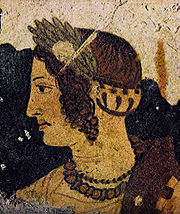
Tomb of Orcus
Encyclopedia

Etruscan civilization
Etruscan civilization is the modern English name given to a civilization of ancient Italy in the area corresponding roughly to Tuscany. The ancient Romans called its creators the Tusci or Etrusci...
hypogeum
Hypogeum
Hypogeum or hypogaeum literally means "underground", from Greek hypo and gaia . It usually refers to an underground, non-Christian temple or a tomb...
(burial chamber) in Tarquinia
Tarquinia
Tarquinia, formerly Corneto and in Antiquity Tarquinii, is an ancient city in the province of Viterbo, Lazio, Italy.- History :Tarquinii is said to have been already a flourishing city when Demaratus of Corinth brought in Greek workmen...
, Italy
Italy
Italy , officially the Italian Republic languages]] under the European Charter for Regional or Minority Languages. In each of these, Italy's official name is as follows:;;;;;;;;), is a unitary parliamentary republic in South-Central Europe. To the north it borders France, Switzerland, Austria and...
. Discovered in 1868, it displays Hellenistic influences in its remarkable mural
Mural
A mural is any piece of artwork painted or applied directly on a wall, ceiling or other large permanent surface. A particularly distinguishing characteristic of mural painting is that the architectural elements of the given space are harmoniously incorporated into the picture.-History:Murals of...
s, which include the portrait of Velia Velcha, an Etruscan noblewoman
Etruscan society
Etruscan society is mainly known through the memorial and achievemental inscriptions on monuments of Etruscan civilization, especially tombs. This information emphasizes family data. Some contractual information is also available from various sources...
, and the only known pictorial representation of the demon Tuchulcha
Tuchulcha
In Etruscan mythology, Tulchulcha was a chthonic daemon with pointed ears , and hair made of snakes and a beak...
. In general, the murals are noted for their depiction of death, evil, and unhappiness.
Because the tomb was built in two sections at two stages, it is sometimes referred to as the Tombs of Orcus I and II; it is believed to have belonged to the Murina family, an offshoot of the Etruscan
Etruscan society
Etruscan society is mainly known through the memorial and achievemental inscriptions on monuments of Etruscan civilization, especially tombs. This information emphasizes family data. Some contractual information is also available from various sources...
Spurinna
Titus Vestricius Spurinna
Titus Vestricius Spurinna was an Etruscan haruspex most famous for warning Julius Caesar to be wary of the Ides of March a month before his assassination....
e. The foundation is inscribed with the following enigmatic phrase:
History
Orcus I was built between 470470 BC
Year 470 BC was a year of the pre-Julian Roman calendar. At the time, it was known as the Year of the Consulship of Potitus and Mamercus...
and 450 BC
450 BC
Year 450 BC was a year of the pre-Julian Roman calendar. At the time, it was known as the Second year of the decemviri...
(perhaps by a man named Leive; see below); a separate hypogeum
Hypogeum
Hypogeum or hypogaeum literally means "underground", from Greek hypo and gaia . It usually refers to an underground, non-Christian temple or a tomb...
, Orcus II, was built c
Circa
Circa , usually abbreviated c. or ca. , means "approximately" in the English language, usually referring to a date...
. 325 BC
325 BC
Year 325 BC was a year of the pre-Julian Roman calendar. At the time, it was known as the Year of the Consulship of Camillus and Scaeva...
. At some point in antiquity the wall between the two was removed, creating a large tomb with two dromes
Dromos
Dromos can refer to:* the cursus publicus, the public road system of the Roman and Byzantine empires;* Dromos in architecture, an entrance passage;* also modes used in Greek music....
(entrances).
The tomb was excavated in 1868 by an officer of the French Army
French Army
The French Army, officially the Armée de Terre , is the land-based and largest component of the French Armed Forces.As of 2010, the army employs 123,100 regulars, 18,350 part-time reservists and 7,700 Legionnaires. All soldiers are professionals, following the suspension of conscription, voted in...
. Upon its discovery, the excavator mistook the painting of a cyclops for the Roman god Orcus (see below), hence the name "Tomb of Orcus". The Italian
Italian language
Italian is a Romance language spoken mainly in Europe: Italy, Switzerland, San Marino, Vatican City, by minorities in Malta, Monaco, Croatia, Slovenia, France, Libya, Eritrea, and Somalia, and by immigrant communities in the Americas and Australia...
name (Tomba dell'Orco) can also mean "Tomb of the Ogre", and it is used that way in Italy
Italy
Italy , officially the Italian Republic languages]] under the European Charter for Regional or Minority Languages. In each of these, Italy's official name is as follows:;;;;;;;;), is a unitary parliamentary republic in South-Central Europe. To the north it borders France, Switzerland, Austria and...
today.
The second tomb has never been fully excavated.
Murals
Though most of the walls are muraled, the artists did not complete the ceiling. A scientific analysis in 2001 revealed that the paint used contained cinnabarCinnabar
Cinnabar or cinnabarite , is the common ore of mercury.-Word origin:The name comes from κινναβαρι , a Greek word most likely applied by Theophrastus to several distinct substances...
, ochre, orpiment
Orpiment
Orpiment, As2S3, is a common monoclinic arsenic sulfide mineral. It has a Mohs hardness of 1.5 to 2 and a specific gravity of 3.46. It melts at 300 °C to 325 °C...
, calcite
Calcite
Calcite is a carbonate mineral and the most stable polymorph of calcium carbonate . The other polymorphs are the minerals aragonite and vaterite. Aragonite will change to calcite at 380-470°C, and vaterite is even less stable.-Properties:...
, copper
Copper
Copper is a chemical element with the symbol Cu and atomic number 29. It is a ductile metal with very high thermal and electrical conductivity. Pure copper is soft and malleable; an exposed surface has a reddish-orange tarnish...
, and Egyptian blue
Egyptian Blue
Egyptian blue is chemically known as calcium copper silicate . It is a pigment used by Egyptians for thousands of years. It is considered to be the first synthetic pigment. The pigment was known to the Romans by the name caeruleum...
. While the artwork in Orcus I is highly praised (particularly the painting of Velia Velcha; see below), some of the artwork of Orcus II is considered poorly done.
It is likely that the French excavators of the tomb tried to remove some of the murals for exhibition in the Louvre
Louvre
The Musée du Louvre – in English, the Louvre Museum or simply the Louvre – is one of the world's largest museums, the most visited art museum in the world and a historic monument. A central landmark of Paris, it is located on the Right Bank of the Seine in the 1st arrondissement...
, which resulted in significant deterioration.
Orcus I

Battle of Syracuse
Battles of Syracuse may refer to:* first and second Battles of Syracuse in 415 and 414 BC, where Athens fought the Syracusans and Spartans* Battle of Syracuse in 387 BC, during one of the Carthaginian campaigns in Sicily....
. The banqueters are surrounded by demons who serve as cupbearers.
One of the banqueters is a noblewoman named Velia Velcha (or by some interpretations, Velia Spurinna), whose portrait has been called the "Mona Lisa
Mona Lisa
Mona Lisa is a portrait by the Italian artist Leonardo da Vinci. It is a painting in oil on a poplar panel, completed circa 1503–1519...
of antiquity
Classical antiquity
Classical antiquity is a broad term for a long period of cultural history centered on the Mediterranean Sea, comprising the interlocking civilizations of ancient Greece and ancient Rome, collectively known as the Greco-Roman world...
". Her realistic profile (especially her eye) bears the influence of Hellenistic art. Unlike the Mona Lisa, however, she is noted for her grimace
Grimace
Grimace may refer to:*A type of facial expression usually of disgust, disapproval, or pain*Grimace , a French composer active in the mid-to-late 14th century*Grimace , a McDonald's character in TV commercials...
or sneer
Sneer
A sneer is a facial expression of scorn or disgust characterized by a slight raising of one corner of the upper lip, known also as curling the lip or turning up the nose...
.
Orcus II
The Tomb of Orcus II (sometimes distinguished as the Tomb of Orcus) was constructed around 325 BC. Its entrance is guarded by paintings of "CharunCharun
In Etruscan mythology, Charun acted as one of the psychopompoi of the underworld, not to be confused with the lord of the underworld, known to the Etruscans as Aita...
" (Charon
Charon (mythology)
In Greek mythology, Charon or Kharon is the ferryman of Hades who carries souls of the newly deceased across the rivers Styx and Acheron that divided the world of the living from the world of the dead. A coin to pay Charon for passage, usually an obolus or danake, was sometimes placed in or on...
), the keeper of the underworld, and a cyclops
Cyclops
A cyclops , in Greek mythology and later Roman mythology, was a member of a primordial race of giants, each with a single eye in the middle of his forehead...
(possibly Polyphemus
Polyphemus
Polyphemus is the gigantic one-eyed son of Poseidon and Thoosa in Greek mythology, one of the Cyclopes. His name means "much spoken of" or "famous". Polyphemus plays a pivotal role in Homer's Odyssey.-In Homer's Odyssey:...
or Geryon
Geryon
In Greek mythology, Geryon , son of Chrysaor and Callirrhoe and grandson of Medusa, was a fearsome giant who dwelt on the island Erytheia of the mythic Hesperides in the far west of the Mediterranean. A more literal-minded later generation of Greeks associated the region with Tartessos in southern...
). When the tomb was originally discovered, the cyclops was mistaken for the Roman god of the underworld, Orcus
Orcus
Orcus was a Roman god of the underworld.Orcus can also refer to:* Orcus , a demon prince in the Dungeons & Dragons role-playing game*90482 Orcus, a Trans-Neptunian object* Orcus , a genus of ladybird...
(hence the tomb's name).
The back wall depicts a funeral procession overseen by "Aita
Aita
Aita is the name of the Etruscan equivalent to the Greek Hades, the divine ruler of the underworld...
" (Hades
Hades
Hades , Hadēs, originally , Haidēs or , Aidēs , meaning "the unseen") was the ancient Greek god of the underworld. The genitive , Haidou, was an elision to denote locality: "[the house/dominion] of Hades". Eventually, the nominative came to designate the abode of the dead.In Greek mythology, Hades...
), the Etruscan god of the underworld, and his wife "Phersipnei" (Persephone
Persephone
In Greek mythology, Persephone , also called Kore , is the daughter of Zeus and the harvest-goddess Demeter, and queen of the underworld; she was abducted by Hades, the god-king of the underworld....
). The left wall is believed to depict Agamemnon
Agamemnon
In Greek mythology, Agamemnon was the son of King Atreus and Queen Aerope of Mycenae, the brother of Menelaus, the husband of Clytemnestra, and the father of Electra and Orestes. Mythical legends make him the king of Mycenae or Argos, thought to be different names for the same area...
, Tiresias
Tiresias
In Greek mythology, Tiresias was a blind prophet of Thebes, famous for clairvoyance and for being transformed into a woman for seven years. He was the son of the shepherd Everes and the nymph Chariclo; Tiresias participated fully in seven generations at Thebes, beginning as advisor to Cadmus...
, and Ajax
Ajax (mythology)
Ajax or Aias was a mythological Greek hero, the son of Telamon and Periboea and king of Salamis. He plays an important role in Homer's Iliad and in the Epic Cycle, a series of epic poems about the Trojan War. To distinguish him from Ajax, son of Oileus , he is called "Telamonian Ajax," "Greater...
in the underworld.
"These" (Theseus
Theseus
For other uses, see Theseus Theseus was the mythical founder-king of Athens, son of Aethra, and fathered by Aegeus and Poseidon, both of whom Aethra had slept with in one night. Theseus was a founder-hero, like Perseus, Cadmus, or Heracles, all of whom battled and overcame foes that were...
) and the Etruscan equivalent of Pirithous
Pirithous
In Greek mythology, Pirithous - Πειρίθοος was the King of the Lapiths in Thessaly and husband of Hippodamia, at whose wedding the famous Battle of Lapiths and Centaurs occurred....
are seated at a table on the right wall, playing a board game
Board game
A board game is a game which involves counters or pieces being moved on a pre-marked surface or "board", according to a set of rules. Games may be based on pure strategy, chance or a mixture of the two, and usually have a goal which a player aims to achieve...
, where they are threatened by the Etruscan demon
Daemon (mythology)
The words dæmon and daimôn are Latinized spellings of the Greek "δαίμων", a reference to the daemons of Ancient Greek religion and mythology, as well as later Hellenistic religion and philosophy...
"Tuchulcha
Tuchulcha
In Etruscan mythology, Tulchulcha was a chthonic daemon with pointed ears , and hair made of snakes and a beak...
", who is pictured with pointed ears, a hairy face, and a hooked beak, wielding snakes in his hands. The tomb is unique in that it bears the only known historical portrayal of this demon.
Inscription
An inscription in the foundation of the tomb reads as follows:
LARΘIALE HVLΧNIESI MARCESIC CALIAΘESI MVNSLE NACNVAIASI ΘAMCE LE…
This has come to be understood as:
Larthiale Hulchniesi Marcesi Caliathesi munisule nacnvaiasi thamuce Le…
The names "Larthiale Hulchniesi" and "Marcesi[c] Caliathesi" are in the dative case
Dative case
The dative case is a grammatical case generally used to indicate the noun to whom something is given, as in "George gave Jamie a drink"....
, and thus mean "for/to Larth Hulchnie" and "for/to Marce *Caliathe" respectively; "nacnvaiasi" is also dative, from the Etruscan
Etruscan language
The Etruscan language was spoken and written by the Etruscan civilization, in what is present-day Italy, in the ancient region of Etruria and in parts of Lombardy, Veneto, and Emilia-Romagna...
noun nacnvaia, "those who come next" (i.e., posterity); the noun "mun[i]s[u]le" refers to any underground monument (and not exclusively to tombs); the verb "tham[u]ce" means "established"; the final "Le…" is the Etruscan letters LE clipped off, though a portion of the next letter is visible, sometimes interpreted as an "i"; the entire name "Leive" has been suggested.
The phrase then translates:
Le[ive] erected this monument to Larth Hulchnie and Marce Caliathe for posterity.
Larth Hulchnie is believed to have been the magistrate
Magistrate
A magistrate is an officer of the state; in modern usage the term usually refers to a judge or prosecutor. This was not always the case; in ancient Rome, a magistratus was one of the highest government officers and possessed both judicial and executive powers. Today, in common law systems, a...
of Tarquinia
Tarquinia
Tarquinia, formerly Corneto and in Antiquity Tarquinii, is an ancient city in the province of Viterbo, Lazio, Italy.- History :Tarquinii is said to have been already a flourishing city when Demaratus of Corinth brought in Greek workmen...
in the 4th century BC, and Marce Caliathe is believed to have been his "representative".
Whether the transcription means, however, that Larth Hulchnie and Marce Caliathe were buried in the tomb is debated, especially since they were not Spurinnae; most scholars believe that the monument was simply dedicated to the magistrates. Etruscologist
Etruscology
Etruscology is the study of the ancient Italian civilization of the Etruscans, which was incorporated into an expanding Roman Empire during the period of Rome's Middle Republic...
s Giuliano and Larissa Bonfante have suggested that the passage is incomplete and would have originally specified "during the magistracy" of Hulchnie and Caliathe (confer zilci Velusi Hulchniesi, "during the magistracy of Velu Hulchnie", found elsewhere in the tomb). According to this interpretation, the phrase would translate:
Le[ive] erected this monument for posterity [during the magistracy] of Larth Hulchnie and Marce Caliathe.
"Marce" is probably a cognate or preform of "Marcus
Marcus (name)
Marcus is a masculine given name of Ancient Roman pre-Christian origin derived probably from Etruscan Marce of unknown meaning, or referring to the mythological figure Mars...
". "Hulchnie" is generally interpreted as the Roman
Latin
Latin is an Italic language originally spoken in Latium and Ancient Rome. It, along with most European languages, is a descendant of the ancient Proto-Indo-European language. Although it is considered a dead language, a number of scholars and members of the Christian clergy speak it fluently, and...
gens
Gens
In ancient Rome, a gens , plural gentes, referred to a family, consisting of all those individuals who shared the same nomen and claimed descent from a common ancestor. A branch of a gens was called a stirps . The gens was an important social structure at Rome and throughout Italy during the...
"Fulcinius
Gaius Fulcinius
Gaius Fulcinius was a Roman envoy to the colony of Fidenae. According to Livy, he was one of four Roman ambassadors murdered on the orders of the Veientine Lars Tolumnius.-References:*Livy 4.16...
", and "Larth" is believed to be akin to the Greek
Greek language
Greek is an independent branch of the Indo-European family of languages. Native to the southern Balkans, it has the longest documented history of any Indo-European language, spanning 34 centuries of written records. Its writing system has been the Greek alphabet for the majority of its history;...
name "Laertēs
Laertes
In Greek mythology, Laërtes was the son of Arcesius and Chalcomedusa. He was the father of Odysseus and Ctimene by his wife Anticlea, daughter of the thief Autolycus. Laërtes was an Argonaut and participated in the hunt for the Calydonian Boar...
"; some have suggested that Larth Hulchnie means "Hulchnie, son of Larth".

